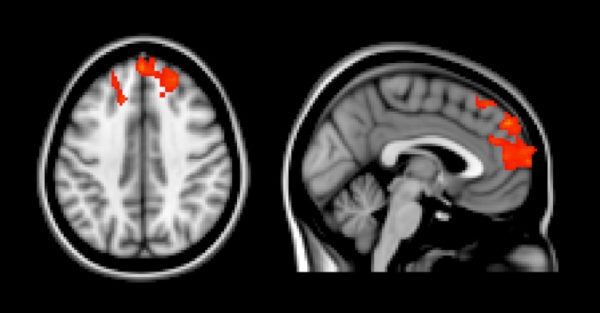Communication in brain activity in people with autism are unusually consistent over seconds — and even years, two new studies suggest.1,2
One study shows that patterns of connectivity remain stable in autistic adolescents, whereas they tend to change and specialize in controls. The other study found that connections remain fixed longer in people with autism than in controls. Both focused on so-called ‘functional connectivity,’ the extent to which the activity of pairs of brain areas is synchronized.

Connections between social and decision-making networks (red spots) typically grow over time, but autistic individuals don’t show this pattern
Together, the studies may help untangle seemingly contradictory findings on connectivity in autism: reports of both underconnectivity and overconnectivity in the brain.
“Maybe the primary abnormality isn’t just that things are too weakly or strongly connected, that it has more to do with the timing of brain connections,” says Jeff Anderson, professor of radiology at the University of Utah, who led the second study.
The studies also highlight the importance of measuring brain activity over varying time periods and at different ages.
Researchers who home in on a single age may overlook differences that appear over time, says Mirella Dapretto, professor of psychiatry and biobehavioral sciences at the University of California, Los Angeles, and lead researcher on the adolescent study. “You miss some of the bigger picture.”
Studying brain activity over time provides a rare window into the development of connectivity.
“This is one of the only papers I’ve seen so far that tries to tackle that by doing it longitudinally,” says Lucina Uddin, associate professor of psychology at the University of Miami in Florida, who was not involved in the work. “You see that there may be a different developmental trajectory in autism.”
Tracking Teenagers
Dapretto and her team scanned the brains of 16 adolescents with autism and 22 controls at rest when they were 11 to 14 years old, and again about three years later.
The researchers measured connectivity among three brain networks thought to be altered in autism: the default mode network, which plays a role in self-reflection; the salience network, which directs attention; and the central executive network, which governs decision-making and other cognitive tasks.
In controls, from early to late adolescence, connectivity increases significantly between the central executive and default mode networks. And as activity increases in one, it decreases in the other. This shift suggests that the networks become more specialized, performing distinct functions.
In the autism group, however, connectivity in these networks remains stable and does not appear to specialize.
This altered development may arise from genetics or as a result of an individual’s experiences or environment.
“There [are] also abnormalities or alterations in the way the brain gets wired as a function of learning and experience,” Dapretto says. For instance, social struggles may affect brain development in autistic adolescents.
Lasting Links
In the second study, Anderson and his colleagues scanned the brains of 52 individuals with autism and 38 controls, aged 15 to 57 years. They measured connectivity across intervals from 1 to 31 seconds in 17 networks and 361 regions. (Standard analyses look only at instantaneous connectivity.)
They found that connectivity between regions lasts significantly longer in the autism group than in controls. The difference is greatest in networks that play a role in sensory processing, attention and self-reflection.
“These networks hold on to brain activity for too long; they are too stable,” Anderson says.
The degree of connectivity is only slightly different between groups at any point in time; bigger differences emerge over six seconds or longer. Anderson and his team confirmed these results in data from 579 individuals with autism and 823 controls from the Autism Brain Imaging Data Exchange.
The findings add to evidence of overly stable brain activity in autism.
“Previous studies, including ours, show stability in brain-activity transition,” says Takamitsu Watanabe, deputy team leader at the RIKEN Center for Brain Science in Japan, who was not involved in the work. “But [the researchers] show the stability of functional connectivity, so I think it’s kind of a new aspect of this study.”
The longer connectivity lasts, the more pronounced the person’s autism traits, as measured by the Social Responsiveness Scale, the study found.
“If your brain gets stuck in one state for too long, that might allow you to do some types of processing very well,” Anderson says. However, he says, “it doesn’t allow you to do the complex types of processing that combine information from different parts of the brain together.” For example, social interactions might require connections to be more flexible.
Identifying the patterns linked to autism features may help researchers target treatments, Watanabe says. Tools such as transcranial magnetic stimulation may interrupt persistent brain signals.
In an ongoing study, Anderson’s team plans to study how the timing of connectivity shifts during development. And Dapretto’s group aims to track connectivity patterns into adulthood.
This article is reprinted with permission. You may view the original article, published on 14, January, 2019, at www.spectrumnews.org/news/communication-brain-may-remarkably-constant-autism/.
Additional Articles of Interest
- Social Communication in Autism Explained
- Sibling study bolsters genetic link between autism, attention deficit
- Post-traumatic stress disorder may mimic autism in some children
- How pregnancy may shape a child’s autism
Footnotes
- Lawrence K.E. et al. Autism Res. 12, 53-65 (2019) PubMed: https://www.ncbi.nlm.nih.gov/pubmed/30375176
- King J.B. et al. JAMA Netw.Open1, e184777 (2018) Full text: https://jamanetwork.com/journals/jamanetworkopen/fullarticle/2714506




